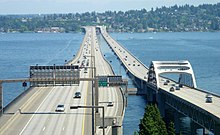Interstate 90 floating bridges

The Interstate 90 floating bridges are two floating bridges in the state of Washington that carry Interstate 90 across Lake Washington between Seattle and Mercer Island. The bridge names are the Lacey V. Murrow Memorial Bridge and the Homer M. Hadley Memorial Bridge.
Homer Hadley proposed a bridge crossing Lake Washington in 1920.[1] Construction began on the original bridge in 1939 and was completed in 1940. The bridge was named after Lacey V. Murrow. The construction was funded by a bond measure, then paid off by tolls. The tolls were subsequently removed in 1949 when the bridge was paid off. The bridge is the second-longest floating bridge in the world. It originally included a draw span that required vehicles to drive around the draw span structure.
As traffic increased, a reversible lane system was introduced, which put some cars on the wrong side of the draw span structure, creating a significant hazard. This prompted the construction of the Homer M. Hadley bridge, which opened in 1989.[2]
After the Hadley bridge opened, the Murrow bridge was closed for renovation. During renovation, an error by construction crews caused some of the pontoons to flood with water, resulting in a portion of the bridge sinking in a storm and causing more than $69 million in damages.
The older Murrow bridge was configured to carry the eastbound lanes of I-90, while the newer Hadley bridge carries the westbound lanes and reversible express lanes.
The bridge is currently being reconfigured.[3] When complete, the Hadley reversible lanes will be converted into the East Link light rail line for Sound Transit. It will be the only floating bridge carrying rail lines in the world.
References
- ^ "The Bridge from Seattle". mercerislandhistory.org. Retrieved 2015-12-17.
- ^ "WSDOT - Historic Bridges". www.wsdot.wa.gov. Retrieved 2015-12-17.
- ^ "Extra $20 million OK'd to finish East Link light-rail design". The Seattle Times. 2015-08-15. Retrieved 2015-12-17.
